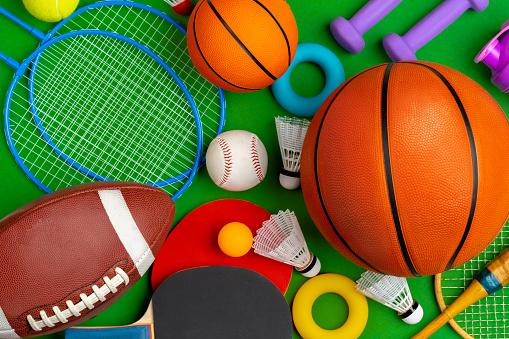Sports Equipment Market Size 2020-2027 SWOT Analysis, Top Trends and Major Key Players Globeride, Inc. (Japan), New Balance Athletics, Inc. (US), Adidas AG (Germany)

Market Scope
Market Research Future (MRFR) expects the sports equipment Industry to procure a CAGR of 3.20% between 2020 and 2027. It is also presumed that the market size shall touch a whopping USD 97.16 Billion by 2027-end.
Growth Boosters & Key Deterrents
Changing perception among consumers with regard to wellness and fitness has had a strong impact on the sports equipment industry. Frequent advances in materials that are used during the manufacturing of various sports equipment help elevate the product quality and performance, thereby resulting in higher adoption. Manufacturers indulge in extensive research and development programs to ensure high quality of their products. At present, carbon fiber is one of the most popular materials used during manufacturing, which is touted to have a positive effect on the global market.
Sensors are increasingly being incorporated into a variety of sports equipment including golf clubs, tennis rackets, swimming goggles, and fishing rods. Sensors help measure the motion and record exhaustive biometric data, which can then be assessed to address the issues related to the swing, stroke or cast of the user.
The biggest growth influencer, however; has been the e-commerce sector, as more and more consumers are inclining towards online platforms to buy products. Besides, the surge in media coverage pertaining to several global sports events like Commonwealth Games, FIFA World Cup and the Olympic Games has been encouraging youths to partake in sports.
To get more info: https://www.marketresearchfuture.com/press-release/global-sports-equipment-market
Segmental Analysis
The market for sports equipment has been considered for type as well as distribution channel.
The different sport equipment types are sticks, balls, sports gear, nets and goalposts, bats, & clubs, and others. Between these, the balls segment should lead and also capture the fastest CAGR over the evaluation period.
Various distribution channels selling a variety of sports equipment are store-based along with non-store-based. While the store-based segment will seize the biggest share in the market, the fastest growth rate will be secured by the non-store-based segment between 2020 and 2027.
Regional Study
The sports equipment industry is regionally segregated into Asia Pacific (APAC), Europe and North America as well as MEA or Middle East & Africa.
North America is home to numerous renowned sports equipment manufacturers, which is one of the reasons for the region’s lead in the global market. High popularity of different sports such as soccer, baseball, basketball, and hockey, are also responsible for the incredible market growth in the United States and Canada. High internet connectivity and the resultant growth of the e-commerce sector in the region has been favorable as well. Customers across the region look out for the best and reasonable prices while online shopping, which has led to booming sales of sports equipment, as manufacturers leverage this opportunity to gain higher profit margins.
The notable expansion rate of the organised retail sector and the surging number of sports activities as consumers take interest in health and fitness have made APAC the fastest advancing market for sports equipment. A trend emerging rapidly in the region is manufacturers combining athletic and casual designs while developing sports equipment. Additionally, the surge in the urbanization rate, improving living standards, and escalating disposable income of consumers should translate into substantial market growth over the following years.
Reputed Firms
Globeride, Inc. (Japan), New Balance Athletics, Inc. (US), Adidas AG (Germany), Quiksilver, Inc. (Australia), MIZUNO Corporation (Japan), Kering S.A. (France), Sports Direct International plc (UK), Shenzhen Taishan Sports Technology Co., Ltd (China), Yonex Co., Ltd (Japan), Nike, Inc. (US), Black Diamond Equipment, Ltd (US), Daei Sportswear & Equipment (Iran), BPS, Direct, LLC (US), Callaway Golf Company (US), ANTA Sports Products Limited (China), are the major brands in the sports equipment industry.
Most of these players employ numerous initiatives including partnerships, acquisitions, mergers and launch a variety of sports equipment with better features to remain competitive. The companies are also focused on adopting modern technologies to offer a better retail customer experience while also providing an immersive shopping experience via online channels. A major trend making rounds in the global market is sustainability, in the face of mounting environmental concerns. Brands are therefore, leveraging this opportunity and developing eco-friendly sports equipment that not only caters to the consumers tastes but also accommodates the sustainability trend.
To illustrate, in April 2021, Nike unveiled Next Nature Football, a football made completely using 100% recycled yarn. The football’s outer shell contains recycled airbags that renders it free flowing while the outer shell contains recycled airbag scraps. Its fillings are entirely recycled yarn trimmings that are derived from landfills.
- Industry
- Art
- Causes
- Crafts
- Dance
- Drinks
- Film
- Fitness
- Food
- Games
- Gardening
- Health
- Home
- Literature
- Music
- Networking
- Other
- Party
- Religion
- Shopping
- Sports
- Theater
- Wellness
- News


